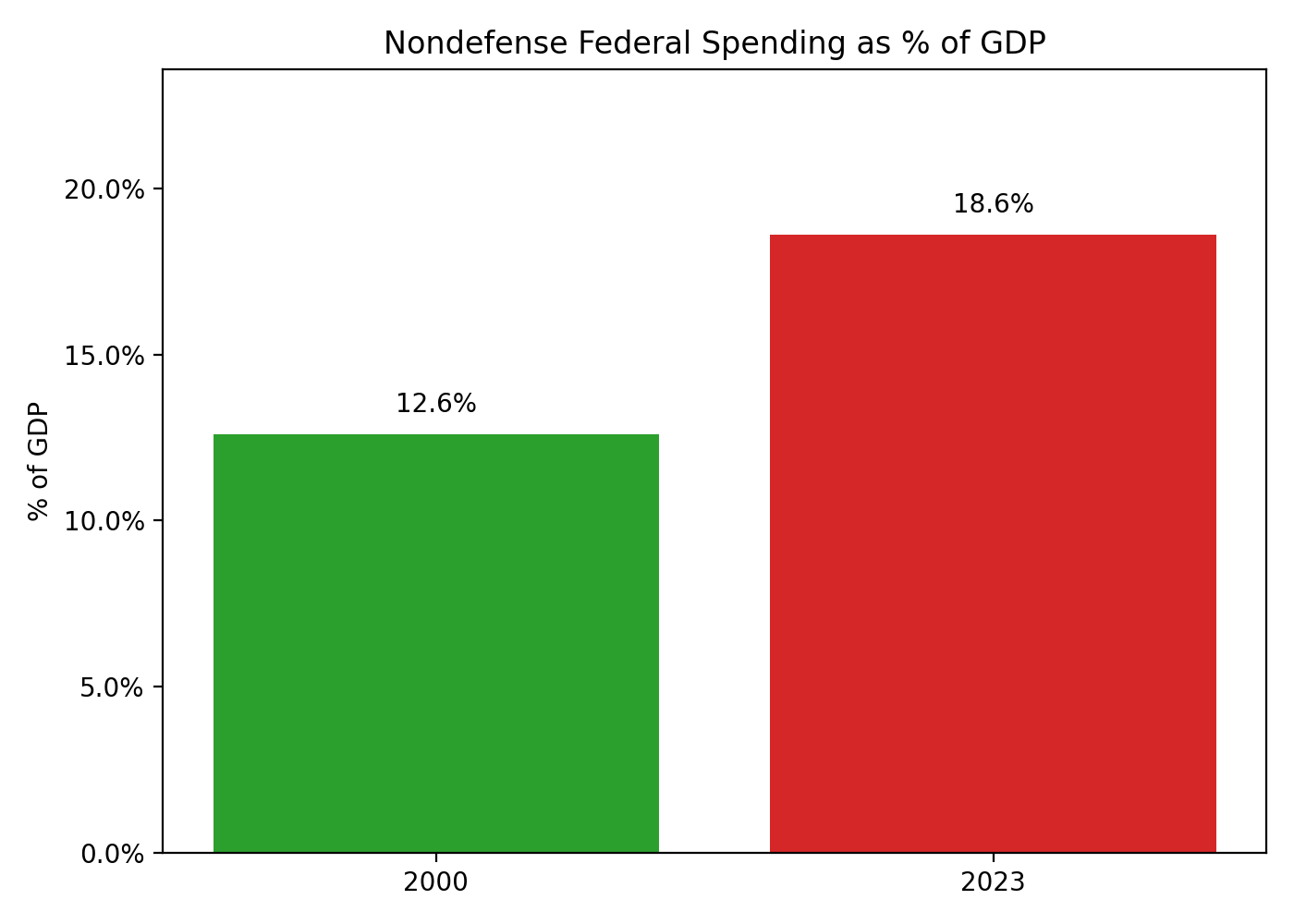Summary
As private enterprise business processes bring efficiencies such as automation (AI), the government apparatus acts as a barrier because it knows it will eliminate the need for otherwise useless labor union jobs. So, they fight back with all the might of an entrenched bureaucracy of a monopoly, a powerful enterprise. It is of little consequence that these non-essential and dispensable individuals accomplish little more than drawing a fat paycheck and planning for a luxurious early retirement. The taxpayers’ and borrowed funds support is an inefficient apparatus.
Introduction
The federal civilian headcount has hovered slightly above 2 million for decades—even as population, spending, and mission complexity have soared—so the real “bloat” problem is less about headcount and more about how we organize, compensate, contract, and finance government work.
It is impossible to provide an exact number of federal agencies because there is no single, authoritative list of them. The number can vary depending on how an “agency” is defined and which government list is consulted. Estimates from different government sources range from a few hundred to over 2,000.
As of July 2025, approximately 12,674 registered lobbyists are currently working in federal government activities. The exact number of public relations specialists working for the government is not officially tracked; however, in 2014, there were approximately 5,000 federal employees classified in the “Public Affairs” occupational series.
- Federal lobbying spending continues to reach record highs, reaching $4.5 billion in 2024. This reflects the increasing activity of lobbyists and lobbying firms who work for corporations, trade associations, and advocacy groups.
- Many lobbyists are former government officials or congressional staffers, a phenomenon known as the “revolving door”.
- An analysis from 2021 noted that more than 50% of former members of Congress who left office in 2019 went on to become lobbyists or advisors in similar roles.
- Expert James A. Thurber has estimated that the actual number of people working in the lobbying industry in D.C. is closer to 100,000 when accounting for those who do not officially register for lobbying activities.
- Significant presence of lawyers in public policy: In 2014, there were an estimated 80,000 lawyers in Washington, D.C., many of whom were engaged in public policy work.
The use of outside contractors, separating institutions, and disguised non-profits has blurred the lines between bloated inefficiencies and waste, as well as fraud and abuse.
Reform should target:
· The blurred line between federal roles and contractors,
· Benefits and liabilities that outpace revenues,
· Rigid labor rules that raise costs without consistently improving outcomes.
Article:
The Scale of Bureaucracy
- As of 2024, the federal government employed a staggering 2.4 million civilian workers, excluding the U.S. Postal Service (636,966 employees) and 2.9 million military personnel. This scale of bureaucracy is a significant challenge that needs to be addressed.
- Despite decades of technological advances, the civilian workforce has remained essentially unchanged for 50 years, even as federal spending quintupled and the U.S. population grew by 68%.
- Contractors now outnumber federal employees more than 2-to-1, creating a “blended workforce”. This term refers to a workforce that includes both traditional employees and contracted workers, raising questions about accountability and efficiency in managing such a diverse workforce.
The Cost to Taxpayers
- Federal personnel costs account for approximately 7% of all federal spending, resulting in hundreds of billions of dollars annually. This is a significant financial burden on taxpayers.
- The government’s gross operating cost in FY 2023 was $7.7 trillion, with a net cost of $7.9 trillion after adjustments. Total liabilities stand at $42.9 trillion, including $14.3 trillion in employee and veteran benefits.
- Non-defense spending has increased from 12.6% of GDP in 2000 to 18.6% in 2023, a 48% rise, driven by programs and administrative overhead rather than core services.
Union Power and Inefficiency
- Public-sector unions significantly increase government costs through higher salaries, generous health benefits, and restrictive work rules that undermine performance.
- Collective bargaining rights often lock agencies into rigid structures, making it nearly impossible to reward merit or eliminate redundant roles.
- Legislative efforts to curb union influence—such as Wisconsin’s Act 10—have sparked national battles, underscoring the significant political clout these unions wield.
Non-Essential Roles: A Hidden Drain
- During shutdowns, thousands of positions are classified as “non-essential”, meaning their absence does not immediately harm public safety or national security. These include administrative support, policy research, and cultural services, such as those provided by museum curators or event planners.
- If these roles can be paused without consequence, why do they persist year-round at taxpayer expense?
The Consequences
- Policy Paralysis: Layers of red tape delay decisions and stifle innovation.
- Fiscal Unsustainability: Debt-to-GDP ratio projected to hit 531% by 2098 under current policy.
- Public Distrust: Citizens see a government that grows in cost but shrinks in effectiveness.
Solutions
· Performance-Based Accountability: Tie job security to measurable outcomes.
· Union Reform: Balance worker rights with public interest.
· Streamline Agencies: Consolidate overlapping departments and eliminate redundant roles.
· Digital Transformation: Automate repetitive tasks to reduce headcount.
· Privatization Where Feasible: Introduce competitive pressure for efficiency.
Conclusion
The real “swamp” isn’t just Corruption—it’s systemic inefficiency. Bureaucracy, fortified by union monopolies, has become Public Enemy Number One. Reform isn’t optional; it’s a fiscal and moral imperative.
